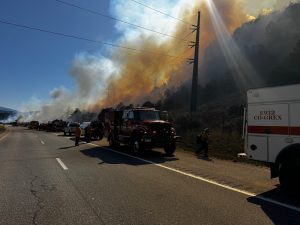Eagle County emergency manager worries that federal disaster response funding is in jeopardy
Feds seem to be shifting disaster relief burden to state, local agencies

Vail Daily archive
Disaster response always starts locally. But when a disaster overwhelms the local response, help has come from state and, more importantly, federal sources. That seems to be changing.
In a Tuesday report to the Eagle County Board of Commissioners, Eagle County Senior Policy Analyst Laura Hartman detailed changes in public assistance funding from the Federal Emergency Management Agency.
Hartman noted that agency hasn’t yet released funding from the Emergency Management Performance Grant pool. Hartman said the state will “backfill” the grant funding, but money won’t be available past Sept. 30 without continued federal funding.
Hartman said Eagle County can expect a 25% reduction in grant funding in its current 2025 budget and can anticipate the funding to be eliminated in 2026.
During the meeting, county Director of Emergency Management Birch Barron called the cut a “big loss,” adding that it seems that the federal agency seems to be expecting state and local officials to take up more of the burden for disaster management.

Support Local Journalism
In a subsequent telephone interview, Barron said there’s been an erosion of federal funding streams. That’s crucial in the case of major disasters that overwhelm local responses.
There’s also been a loss in grants that help build up at-risk infrastructure. The Building Resilient Infrastructure in Communities, or BRIC, grant program, has been sought for programs including rock scaling in Red Cliff and moving infrastructure out of floodplains. That’s no longer available, Barron said.
Barron added there’s also been a “real resistance” recently to issuing presidential disaster declarations, which can help provide funding to cover up to 75% of uninsured losses in case of major disasters.
Barron added those impacts won’t be felt unless Eagle County experiences a catastrophic emergency. Still, he added, even some of the state’s largest recent wildfires — including Cameron Peak, East Troublesome and Marshall — wouldn’t meet the current threshold for a presidential disaster declaration.
“In my world what that means is … our incident command teams may be considering cost when they’re deciding whether or not to authorize life-saving and very essential emergency response resources. And costs should be at the back of their mind,” Barron said.
Then there’s the Emergency Management Performance Grants. Those grants fund emergency management people and their salaries and benefits, which affects Barron personally, of course, as well as emergency management people throughout the state.
The loss of that funding, whether federal or state, means some counties could be in danger of losing their emergency management staff. Those are difficult decisions to make in county seats, he said, since whether federal, state or local, money for those positions has to come from somewhere.
And, with money apparently drying up at the federal level, Barron said it looks like, at least for now, local jurisdictions need to face a sobering reality.
“Eagle County needs to be prepared to continue handling emergencies locally, and with the state of Colorado, without the support of the federal government in the ways it has been available to us in the past,” Barron said. “And if additional support becomes available, we welcome it, but I think at this point our posture is we need to be prepared as if no additional help is coming.”











